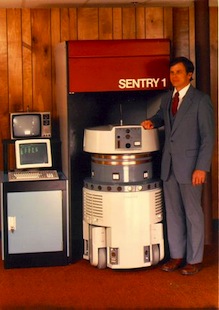 One of my current projects is a think piece about robots, specifically those that may soon be charged with carrying out morally weighty duties. That line of inquiry has led me to delve into the history of robot prison guards—or, perhaps more accurately, robots that were briefly purported to be the prison guards of the future. Such plans have obviously never come to fruition, but the Denning Sentry apparently came close to making the penitentiary rounds back in 1985, when this admiring piece appeared in Popular Science:
One of my current projects is a think piece about robots, specifically those that may soon be charged with carrying out morally weighty duties. That line of inquiry has led me to delve into the history of robot prison guards—or, perhaps more accurately, robots that were briefly purported to be the prison guards of the future. Such plans have obviously never come to fruition, but the Denning Sentry apparently came close to making the penitentiary rounds back in 1985, when this admiring piece appeared in Popular Science:
Southern Steel Co. of San Antonio, Texas, the country’s largest maker of prison bars, beds, and other detention-facility hardware, has ordered 600 copies of Denny; eight of these, destined for prison duty, are now undergoing advanced testing. Denning is also building robot sentries with slightly different capabilities for another private security firm, and still others to patrol factories.
A Denning Sentry can detect, within a 150-foot radius, the presence of anything or anybody that shouldn’t be there, the company claims. Its swiveling head contains microwave and infrared (IR) sensors that can detect people as well as smoke. In future editions the head will also contain sniffers that can smell the faint ammonia aroma of a human body.
Needless to say, the Denning Sentry never fulfilled its promise: its maker, Denning Mobile Robotics, went bankrupt in 1993, though it experienced a brief revival shortly thereafter thanks to Australian robotics guru Allan Branch. The problem does not seem to have been handwringing over the moral issues raised by putting robots in charge of human, but rather because the Sentries cost way too much—about $110,000 in Reagan-era money, not including maintenance. An entry-level human guard, by contrast, runs just $22,010 in today’s dollars.
There doesn’t seem to have been much consideration given to the potential for robot prison guards since the Denning Sentry’s flameout. But I have to think it’s a natural next application for the technology once SUGVs evolve a bit more. Let’s hope folks stop to ponder the moral dimension to that usage—I have to wonder if human guards will be more willing to employ violent measures if they’re operating a robot from a remote location, rather than actually walking the prison floors.
(Image via SPAWAR)


Jordan // Sep 29, 2010 at 3:04 pm
Contra, I wonder if robotic prison guards would actually decrease violence. First, if set up properly, they should transmit all of their data to a secondary source, which would allow complaints to be fairly easily worked out because the videos would be easily viewable. Second, the people operating the robotic guards would no longer have to worry about their own health and safety, so there would be less incentive to lash out or respond to provocation.
Pete Warden // Sep 29, 2010 at 5:38 pm
This reminded me of Newjack: Guarding Sing-Sing:
http://www.amazon.com/Newjack-Guarding-Sing-Ted-Conover/dp/0375726624
The main thing I learned from that book was that prison guard work was worlds away from my naive impressions. The prisoners can easily overwhelm the guards if they get motivated – even though the long-term consequences won’t be pretty, these aren’t people selected for their impulse control. Consequently the whole process seems to be a psychological game of chicken, where the two populations test each other and negotiate implicit or explicit agreements to keep the peace.
Since most of the guard’s work is actually about that sort of face-to-face interaction, I’m struggling to see how a Dalek could be a big help. Checking on a sick prisoner or breaking up a tense situation before it escalates into a fight is hard to handle remotely. Outside of that, guarding the perimeter is easy enough with existing sensors, no robot needed.
Brendan I. Koerner // Sep 29, 2010 at 8:47 pm
@Jordan: Interesting argument, esp. your second point. I don’t know enough about guard-on-prisoner violence to really counter, but what you say makes intuitive sense–the actions intended to provoke will have less effect if they’re intermediated through a robot. That’s something I’ll ponder as I work through this essay.
Brendan I. Koerner // Sep 29, 2010 at 8:49 pm
@Pete Warden: Thanks so much for the thoughtful comment. I am ashamed to say that I haven’t read Newjack, but I intend to correct that oversight shortly. I was on an NYU panel with Ted Conover a few months back, and he was just about the coolest, nicest dude you could ever hope to meet. Needless to say, that experience made me want to read everything the man had every written–the way he exuded intelligent calm convinced me that he must be one helluva reporter. His latest roads book look pretty great, too.
monkeyball // Sep 30, 2010 at 2:30 pm
Do I really need to bother to go to youtube and search for the relevant ED-209 clip?